The first part of an extensive look behind-the-scenes of the visual effects process for Lucasfilm’s pirate-themed Star Wars adventure series.
By Clayton Sandell
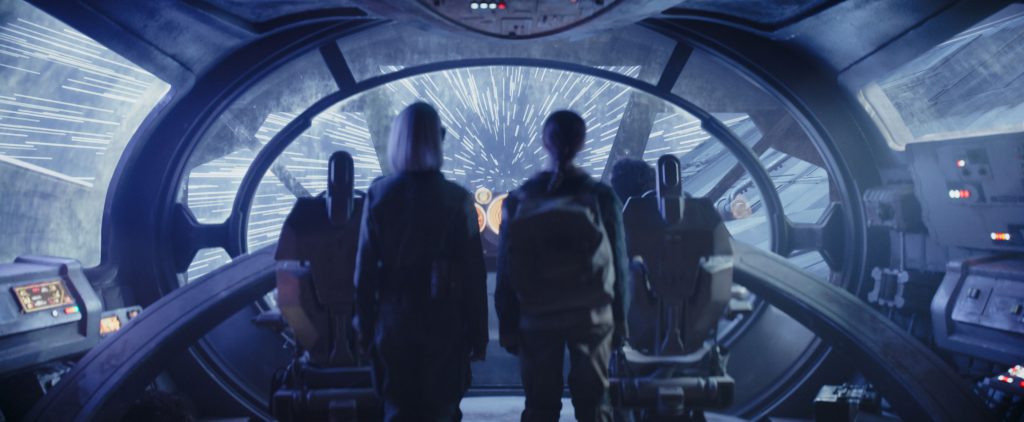
The sprawling, live-action series Star Wars: Skeleton Crew (2024-25) is like a map leading to a visual effects treasure chest. Open it, and you’ll find a trove of 3,200 visual effects shots that seamlessly blend the latest digital artistry along with traditional techniques that both innovate and honor the unique legacy of Industrial Light & Magic.
In creating a new adventure story set in our favorite galaxy far, far away, Skeleton Crew creators and executive producers Jon Watts and Christopher Ford set a delightfully retro tone for the series, which directly informed ILM’s approach to the visual effects.
“Very early on, it was apparent that a big part of the intended charm of the show was that it was going to have this sort of Amblin, 80’s movie sort of vibe to it,” Skeleton Crew production visual effects supervisor John Knoll tells ILM.com. “That extends to more than just how you tell the stories. It also extends to choices like embracing animatronics, monsters, and building miniatures and stop-motion creatures.”
Pulling it off would involve hundreds of talented artists at ILM studios around the globe, including San Francisco, Sydney, Mumbai, and Vancouver, along with a few outside visual effects partners.
Over eight episodes, Skeleton Crew follows the adventures of Wim (Ravi Cabot-Conyers), Neel (Robert Timothy Smith), Fern (Ryan Kiera Armstrong), and KB (Kyriana Kratter)—four kids living a peaceful, if mundane, life on their home world of At Attin. After discovering a mysterious buried space cruiser, the four friends unintentionally launch themselves into hyperspace and must find their way home by navigating a dangerous galaxy of allies, enemies, pirates, and monsters.
Early in preproduction on Skeleton Crew, Knoll says the ILM team had to determine the best way to approach the show’s varied visual effects needs. “It just read like an expensive show because of all of the different planets we go to, all the different types of creatures, and the different environments,” explains Knoll, who also serves as ILM’s executive creative director and senior visual effects supervisor. “Trying to figure out how to make that affordable was one of the first things that faced the visual effects team.”
Following a methodology first established during The Mandalorian (2019-2023), Knoll says Skeleton Crew production was divided roughly into thirds. “About one-third of it was shot in our StageCraft LED volume, one-third was shot on soundstages with conventional sets, and then one-third was shot on a backlot,” Knoll reports.
Galactic Planet-hopping
Skeleton Crew unfolds across multiple worlds that are brand new to Star Wars, beginning with At Attin. The planet’s suburban-like residential neighborhoods utilized a minimal exterior set located near the California State University Dominguez Hills campus in Carson, California. “There was an undeveloped lot that was just adjacent to the campus that was available. So we shot on that,” Knoll says. The practical parts of the set consisted of only the street, a sidewalk, parts of a few houses, and a small patch of grass surrounded by a large blue screen background, says ILM visual effects supervisor Eddie Pasquarello.
“We added all the trees, houses, skies, and trams,” Pasquarello reveals. Even the street was narrowed. “Some things are not seen, and those are the ones that are the most impressive in my opinion, because you’re not saying, ‘Oh, that’s visual effects.’ We’re hoping people watch the actors and enjoy the story versus worrying about the environment.”
Wim and Neel board a tram for the ride to school, a sequence that introduces the more urban areas of At Attin. Artists digitally extended the school’s exterior—shot on another minimal set—and helped create an expansive cityscape designed to suggest At Attin’s backstory.
“[Jon] Watts wanted it to feel like a place that was built some time ago, but it’s been mostly kept up pretty well. And it’s a place where everyone more or less follows the rules,” says ILM animation supervisor Shawn Kelly.
On the ride to school, Wim stares out the tram’s back window as the vehicle drops into an underground tunnel. After the scene was shot, artists were asked to enhance the movement of both the tram and the camera, requiring complex digital layering work to achieve the right perspective. “We had to split apart all the kids inside the bus to get the proper parallax,” Pasquarello explains. “There’s a ton of artists that helped in layout, and comp and environment—all across the board—that made the shot work.”
Pasquarello says a number of ILM teams also worked throughout the production to develop the right look for At Attin’s city architecture. “This was a really Herculean effort,” he notes. “This is a huge environment build from the team. But it also takes the disciplines of animation and lighting.”
In one shot where a malfunctioning hoverbike leaves Fern and KB stranded on the side of the road, Jon Watts asked ILM to enhance the background with a custom building. “He sent us a photo of a mall,” Pasquarello says. “He said, ‘I kind of want it to look like the mall that I remember as a kid.’ And that’s what that is inspired by. We basically took that photo and ‘Star Wars-ified’ it.”
Neel Nation
One of the earliest discussions among the Skeleton Crew creative team was how to bring Wim’s best friend Neel to the screen. “Neel was a fun and interesting challenge,” Kelly tells ILM.com, noting that the blue elephant-like character is a three-way creative partnership combining Smith’s voice and performance, the work of performance artist Kacie Borrowman, and extensive digital creativity.
“The production was feeling like Neel probably needed to be CG throughout,” Knoll says, explaining that the hours spent applying makeup or prosthetics to Smith would have cut into the child performer’s limited shooting window. “Just seeing how often Neel was going to be on screen—he’s on every other page of every script—he was potentially going to be the most expensive part of the entire show,” recounts Knoll, who set a goal of reducing the all-CG Neel shots by half. “I thought, ‘there’s got to be some practical version of Neel that we can do, at least for over-the-shoulder and wide shots.’”
For that mission, ILM turned to Legacy Effects, a frequent collaborator on Star Wars projects including Ahsoka (2023 – present) and Obi-Wan Kenobi (2022). “Neel’s head was built by Legacy as a fully animatronic puppet and was meant to do a lot of the heavy lifting of the performance,” says Pasquarello.
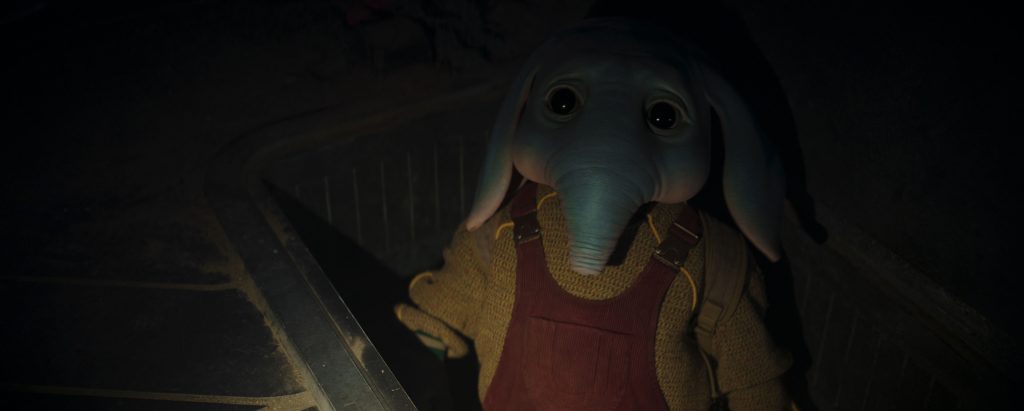
Neel’s many facial expressions developed from an innovative fusion between the Legacy puppet and considerable digital augmentation. “As they started filming the show, everyone fell in love with how the practical puppet face works,” Kelly recalls. “It’s very charming.”
Digital animation took over in scenes where the story called for subtle emotional expressions that were beyond the capability of the puppet, Kelly says, noting that roughly half of Neel’s shots are either digitally augmented or completely CG. “We came up with a bunch of facial expressions,” he explains. “There’s ‘worried.’ We’ve got ‘scared.’ We’ve got ‘sad’ Neel and ‘happy’ Neel, the Neel that we love. Sometimes we just really need to scrunch up his face and we could scrunch it up with or without his ears, things like that.”
Even in shots where the practical puppet head was used on-set, artists digitally-erased a small mesh screen on Neel’s trunk that had allowed the performers inside to see and breathe more easily. ILM lead creature modeler Jonathan Sabella also helped digitally sculpt the CG version of Neel to make sure it was identical to the puppet. “That might just be adjusting neck wrinkles or the trunk, and he can shape it back and make it just right or push the emotion even a little further than our out-of-the-box controls could do. Jonathan was a really key part of bringing this together,” says Kelly.
During shooting, facial capture technology created by ILM Technoprops was used to record Smith’s performance. “In the end, we didn’t use the facial capture directly,” Kelly says, explaining that Neel’s expressions were instead crafted by animators in order to more closely match the style of the puppet.
“We could have gone with a bigger performance,” Pasquarello adds, “but a lot of it was really leaning in and matching the aesthetic that was established. If we were to do something beyond that, it felt wrong because we were losing that kind of simple on-set practical aesthetic, which is a very Star Wars aesthetic. It’s always best to have this mix of different techniques happening at once. It creates the best illusion for the audience. It’s hard to pin down what’s going on if some of it’s real and some of it’s not.”
Rise of the Onyx Cinder
At the bottom of a forest ravine, the kids discover the entrance to a long-buried, hidden starship called the Onyx Cinder. Wim unwittingly activates the dormant vessel, causing it to lurch skyward with the four kids still on board. As massive layers of soil, rocks and trees cascade off the rising ship, the kids try unsuccessfully to escape. “This was a sequence that went on for a while for us,” says Pasquarello. “Just moving all that earth and lifting that ship and having it turn over was a big challenge.”
Live action plates of the four young actors standing on a small set were completed with an entirely digital environment. “The hatch and the four kids. That’s all we had to work with,” Pasquarello remembers. “They were just standing on a small practical piece of the ship, and then everything else was added around them.”
Digital doubles were also created for all the characters and used throughout the sequence, especially useful for shots that might have been perilous for the young actors. “Sometimes when they’re hanging out of the open porthole, they’re animated,” Kelly says. “The animated Wim is waving to his dad.”
Various simulations—from tree leaves, to swirling embers, dust, and engine vortices kicking up dirt—help complete the sequence. “I think this really shows off the world-class effects team and environment team. I’m just always blown away by this sequence,” says Kelly, noting that many of the forest scenes were created with the help of artists in ILM’s Vancouver studio.
Once in space, the kids discover the ship’s first mate, a droid named SM-33 (voiced by Nick Frost). The character was realized using a Bunraku-style puppet (operated by performance artist Rob Ramsdell) and fully-CG versions, depending on the scene.
The Onyx Cinder first came to life as a 3D computer model built by Rene Garcia and Jay Machado and textured by Kim Vongbunyong. Veteran ILM modelmaker John Goodson then crafted a practical version that included rotating sections and flickering LED lights in the engines. “It’s very old school. It’s all handmade. There are a handful of model kit parts on it for detail. But even a lot of those are handmade,” Goodson says. “It’s styrene and acrylic with an aluminum armature inside of it.” Modelmaker Dan Patrascu also helped build the Onyx Cinder chassis and mounted motors inside the model.
“It gets designed in the art department,” Knoll says. “Then you validate the design, so everybody’s happy with it. John builds his version of it. And then we true up our CG model to match what John did. Something I really liked about the model John built was that the paint finish was beautiful on it. And so that was very extensively photographed and then we re-textured the CG model, based on what John had done.”
The practical model was then mounted on a motion-control rig at ILM’s San Francisco studio, reminiscent of the original Dykstraflex system first pioneered during production of Star Wars: A New Hope (1977).
“[Executive producer] Jon Favreau was pretty enthusiastic about wanting to do this back for season one of The Mandalorian, and I was one of the few people still left at the company that used to do motion-control,” says Knoll. “And we figured, ‘We can make this work.’ Probably the biggest obstacle was budget. The reason that we don’t do this as often as we used to is that it’s more expensive than computer graphics. And the best way that I could figure out how to make this affordable for the show was if this was being done as a garage operation.”
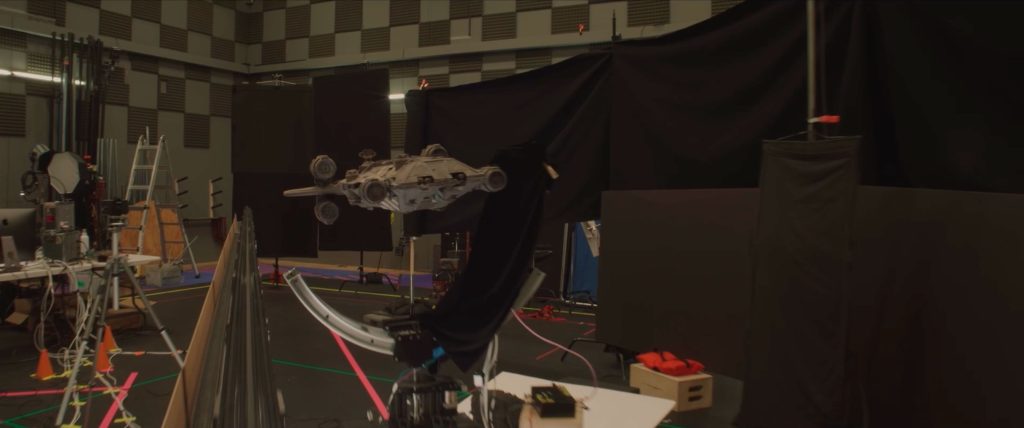
Knoll repurposed the motion-control rig he built in his garage for The Mandalorian, adding the capability to drive more motors on the Onyx Cinder. “The system that I built for season one and two of Mando could drive eight motors,” Knoll recalls. “That gave me track, pan, tilt, and focus, and yaw-pitch-roll on the model. That was sufficient for everything we needed to do with the Razor Crest. But all the engines pivot on the Onyx Cinder, so there are four motorized axes built into the ship. Eight axes isn’t enough to drive all of that. So I expanded the electronics to drive 16 channels.”
Camera moves were first plotted out in Autodesk Maya, approved by the filmmakers, then translated to the motion-control system with a goal of matching a long-established Star Wars aesthetic. “Our approach for the shots that were going to be a miniature is, first—we animate it in the computer, and we figure out, ‘what’s the best way to tell this story?’” says Shawn Kelly. “’What’s the coolest camera move that still feels like an original trilogy camera move that tells the story and has the mood that we want, and the ship has the motion that we need, in the path that we need?’”
The motion-control system was operated by Lindsay Oikawa Pflum and utilized Canon DSLR camera technology. Each shot required a dozen or so passes to capture varieties in exposure and lighting to give compositing teams more options when layering the final image. And in another throwback to ILM’s early days, converters allowed the use of older Nikon lenses that were used to film models for Star Wars: Return of the Jedi (1983). The final result is a flawless collaboration between the real-world model and digital model, all paying homage to ILM’s legacy.
First Stop: Starport Borgo
The Onyx Cinder docks at a nefarious pirate hideaway, a wretched hive called Starport Borgo where the kids hope to find directions back to At Attin. Built into an Outer Rim asteroid overlooking a sea-blue nebula, Borgo is filled with a host of untrustworthy pirates, creatures, and scoundrels. “It’s just a really beautiful, new place for Star Wars,” says Pasquarello.
Port Borgo scenes relied heavily on ILM’s StageCraft LED volume—located at the MBS Media Campus in Southern California. The environment came to life using a combination of practical set pieces along with 3D elements laid out in Unreal Engine and rendered in real-time onto the LED screens. “Creating the content for the volume walls happens nearer to the beginning of our production,” Shawn Kelly says. “There’s a team of generalists, or gen artists, who are talented in a lot of different aspects of computer graphics. And while they are working on the environments, me and a few other people are working on populating those environments.”
“Everything outside is CG,” Pasquarello adds. “When we’re inside in Port Borgo, it’s practical. There’s a lot of storytelling in a very small amount of space.”
Wim, Fern, KB, and Neel disembark the Onyx Cinder and hitch a ride on a bubble-like dinghy piloted by a furry Teek ferryman. Dockside, the Teek jumps on Fern’s shoulder to demand payment—a sequence that demonstrates an invisible combination of digital and practical methods.
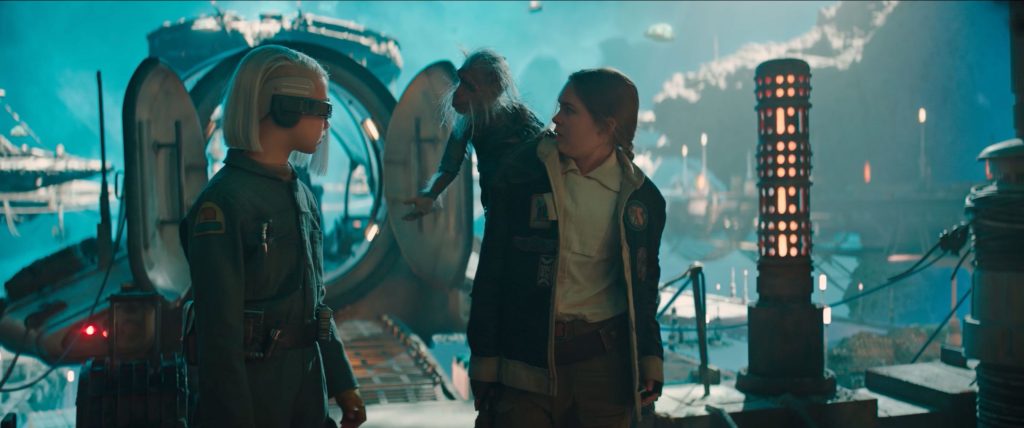
“He’s mostly a practical puppet up on her shoulder, but his arm is animated. His arm is CG so we can do more delicate kinds of gestures with his fingers and hands,” explains Kelly, “but we still try to animate it in a way that feels like a puppet.”
“We have a great paint team here,” adds Pasquarello. “It was not a big deal to remove that arm and replace it.”
Once the Teek gets his money, he jumps down to leave—a shot that features a flawless “Texas Switch” between the practical and fully digital version of the character. “At the beginning, he’s a puppet. And once he goes behind Fern’s back, he’s animated,” Kelly reveals. The shot concludes with the ferryman scurrying away, mimicking the speedy movements of the original Teek that first appeared in Lucasfilm’s TV movie, Ewoks: The Battle for Endor (1985).
“He’s this little, very fast-moving kind of funny guy,” says Kelly. “It was really endearing and fun, especially when I was a kid. So we wanted to put a little bit of that fast movement into him. And this is a little example of how we kept that flavor.”
Motion Capture Cameos
Motion capture performers help populate the expansive setting with hundreds of pirates. “A place like Port Borgo needs to be a bustling port of pirates doing stuff,” says Kelly. “So we spent months at the beginning getting mocap performances and animating on top of those, and also key-framing guys selling stuff at stalls, or shopping at stalls. You’ll see guys in the background unloading a ship, and there’s a chain of guys throwing boxes to each other, stuff like that.”
The children pass by a seedy nightclub where four-armed aliens are dancing in reddish silhouette through frosted windows. It was Kelly’s job to direct the scene’s motion capture performers, including two unexpected names: Daniel Kwan and Daniel Scheinert, collectively known as The Daniels.
At the time, the directors were helming the fourth episode of Skeleton Crew and would soon win an Academy Award for Best Picture for their film Everything Everywhere All at Once (2022). “The Daniels wanted to perform the dance,” Kelly laughs, recalling how it became his job to direct two of his cinematic heroes on how to be better exotic dancers. “I’d say, ‘I think they want it to be sexier.’ They’d just burst out laughing, and do it again,” Kelly says. “They were really fun and funny.”
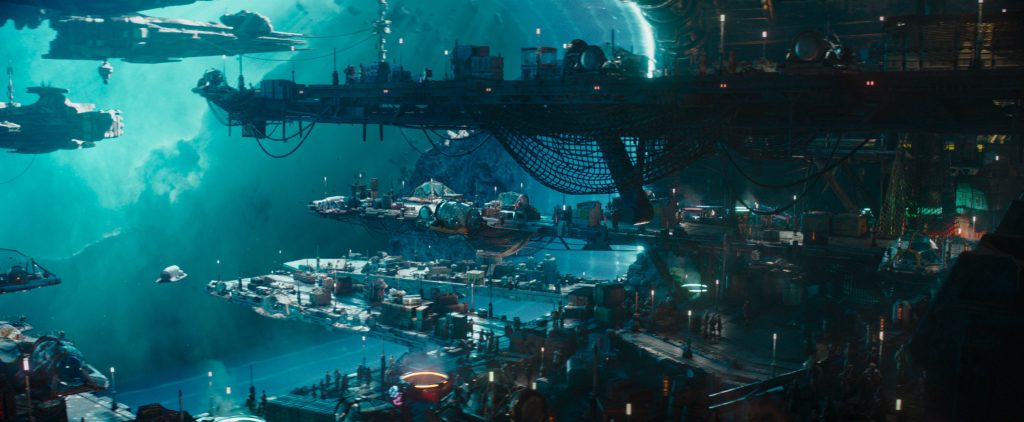
Escape from Port Borgo
Reluctantly teaming up with the mysterious Jod Na Nawood (Jude Law), the children escape from the pirate brig and navigate their way back to the Onyx Cinder. As the ship pulls away. it’s snagged by a refueling line connecting it to a floating buoy, snapping it back like a balloon on a string. Jod tries desperately to maneuver away, dragging several pirate vessels with it.
“They’re creating havoc,” Pasquarello says. “The whole idea of the pile up and pulling those ships together was a really fun sequence, because even Jon Favreau chimed in. Everyone had some ideas about how to make that really successful.”
The colliding ships are all-digital creations, with the action handled by a team of artists who are now part of ILM’s Sydney studio. “All of these ships are CG, and the environment itself as well,” Pasquarello says. “These didn’t exist as models from a practical standpoint.”
As the pirates take aim at the Onyx Cinder with a tower cannon, Jod sends the ship into hyperspace. The fuel line snaps violently, whipping back and crashing into the crowded port. “You can see our animated pirates getting knocked down and running away,” Kelly says. Effects passes helped complete the shot with a variety of explosions, fire, and sparks.
The pileup sequence also gives eagle-eyed viewers a chance to catch a special Easter egg—a Starspeeder 1000 transport, well known to fans of the Star Tours attraction at the Disney Parks.
ILM.com’s behind-the-scenes journey through the creation of Star Wars: Skeleton Crew will continue in part two….
–
Clayton Sandell is a Star Wars author and enthusiast, TV storyteller, and a longtime fan of the creative people who keep Industrial Light & Magic and Skywalker Sound on the leading edge of visual effects and sound design. Follow him on Instagram (@claytonsandell) Bluesky (@claytonsandell.com) or X (@Clayton_Sandell).